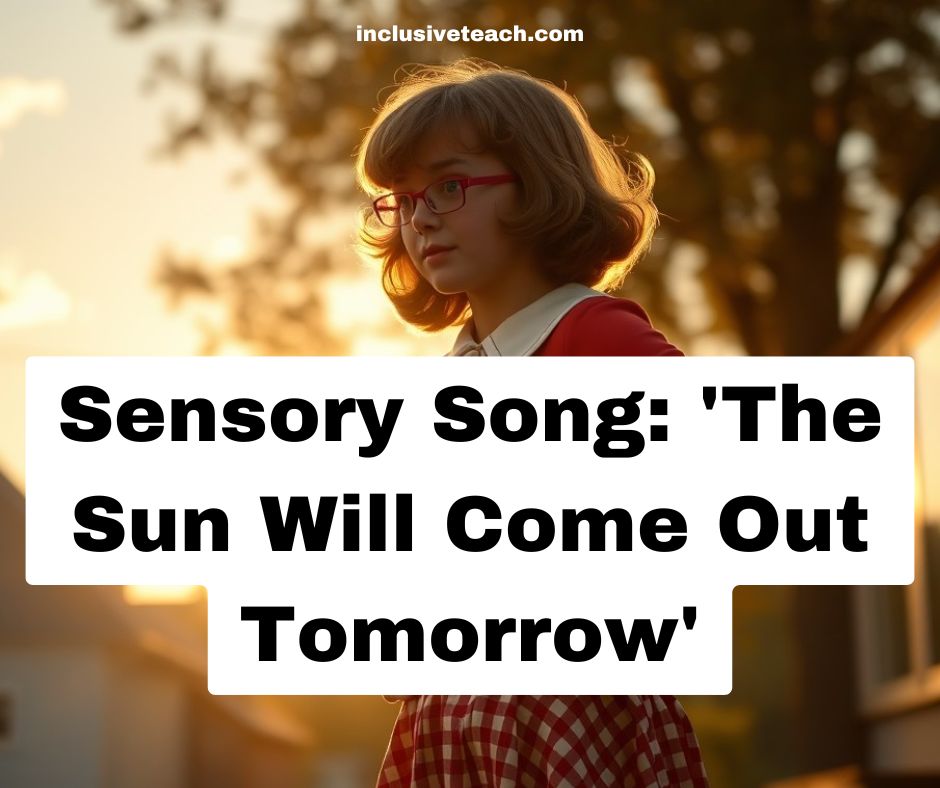
‘The Sun Will Come Out Tomorrow’
Sensory Story: The Sun Will Come Out Tomorrow
Transforming the classic song “The Sun Will Come Out Tomorrow” from the musical Annie into a sensory story allows children to engage with the lyrics through touch, sound, movement, and visuals. This sensory version brings the song to life, helping young learners connect with its themes of hope and positivity in an immersive way. I initially wrote this as part of our Weather topic music activities and it kind of morphed into a positivity focus.

Introduction to the Story
This is focussed on the weather aspect. Begin by explaining to the children:
“Today, we’re going on an adventure to find the sun! Even when the sky is grey, the sun always comes back, bringing warmth, light, and happiness. Let’s see how we can feel, hear, and imagine the sun coming out tomorrow!”
The Sun Will come out: Song with Sensory Enhancements
1. “The sun will come out tomorrow”
- Narration: “The day starts grey and cloudy, but don’t worry—the sun is just hiding behind the clouds! Soon, it will shine bright and warm.”
- Sensory Props:
- Pass around a warm rice sock or a heat pad (representing the sun’s warmth).
- Use a bright yellow scarf or a light-up object to mimic the sun peeking out.
- Play soft, hopeful music on a small speaker or hum a soothing tune to set the mood.
2. “Bet your bottom dollar that tomorrow, there’ll be sun”
- Narration: “Even when it’s hard to see the sun, we can feel it coming back! Let’s bet on it—tomorrow will be brighter!”
- Sensory Props:
- Gently sprinkle water mist onto the children’s hands (a light drizzle, representing the leftover rain).
- Use a flashlight or lamp to slowly brighten the space, symbolising the sun returning after the rain.
- Let the children wave yellow streamers or scarves with optimism as the sun “returns.”
3. “Just thinking about tomorrow clears away the cobwebs and the sorrow”
- Narration: “When we think about tomorrow, the sadness from today starts to disappear, like the morning mist clearing away.”
- Sensory Props:
- Use a feather duster or soft brush to “wipe away” imaginary cobwebs on the children’s arms or hands.
- Create a gentle breeze with a handheld fan to “clear away” the sorrow.
- Play the sound of birds chirping or soft wind chimes, symbolising a fresh, new day.
4. “When I’m stuck with a day that’s grey and lonely, I just stick out my chin and grin and say…”
- Narration: “Sometimes, we feel lonely or sad, but smiling and looking forward to tomorrow can make us feel better!”
- Sensory Props:
- Hand out small mirrors for children to look at themselves and practice smiling.
- Give them a small, soft object (like a plush sun or a comforting toy) to hold and feel its warmth and reassurance.
- Play an upbeat sound effect or clap rhythmically to encourage positivity and energy.
5. “The sun will come out tomorrow, so you gotta hang on ‘til tomorrow”
- Narration: “Even when it feels like today is taking forever, remember that tomorrow is always just a little bit away. The sun always keeps its promise!”
- Sensory Props:
- Shake golden pom-poms or glittery fabric to represent the bright sun shining.
- Slowly raise a large yellow ball (or blow up a yellow balloon) and pass it around the group, letting every child feel the sun “rising.”
- Play the sound of birds singing or the gentle hum of morning to symbolise a new day beginning.
6. “Tomorrow! Tomorrow! I love ya, tomorrow! You’re only a day away”
- Narration: “Tomorrow feels far, but it’s closer than we think! Let’s celebrate the promise of a brighter day!”
- Sensory Props:
- Have children wave blue and yellow scarves to create a “morning sky” effect.
- Encourage them to clap, stomp, or play small percussion instruments to celebrate the joy of tomorrow.
- Dim the lights and then brighten them gradually, symbolising the transition from night to day.
Closing the Sensory Story
- Narration: “And now, the sun has come out! Feel its warmth on your face, imagine its brightness lighting up the sky, and know that tomorrow always comes with new hope and happiness.”
- Sensory Wrap-Up:
- Use a soft, warm blanket to drape over children’s shoulders, symbolising the sun’s comforting warmth.
- Play a cheerful instrumental version of “The Sun Will Come Out Tomorrow” as background music.
- Let the children share how they felt during the story, encouraging them to express their emotions about the sun, clouds, or rain.
Reflection and Follow-Up
After the sensory story, ask the children open-ended questions:
- “What did the warm sun feel like to you?”
- “How did the rain and clouds make you feel?”
- “What do you like most about sunny days?”
You could also follow up with a craft activity, such as making paper suns or drawing pictures of what tomorrow might look like.
This sensory story combines tactile experiences, visual cues, sound effects, and movement to immerse children in the hopeful message of “The Sun Will Come Out Tomorrow.” It supports emotional expression, sensory exploration, and imaginative thinking while reinforcing the concept of resilience and optimism.
Related
Discover more from Special Education and Inclusive Learning
Subscribe to get the latest posts sent to your email.
Source link



